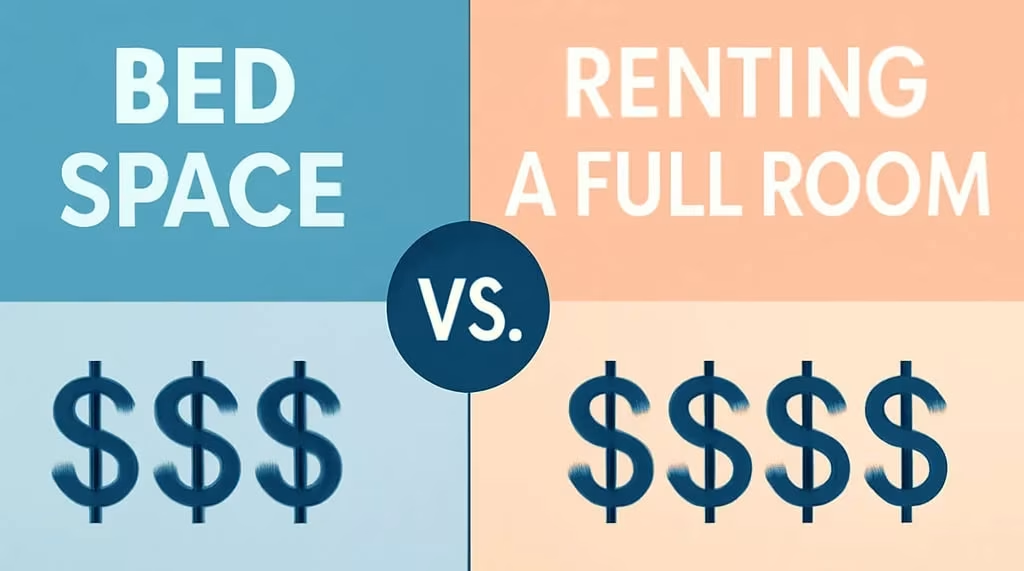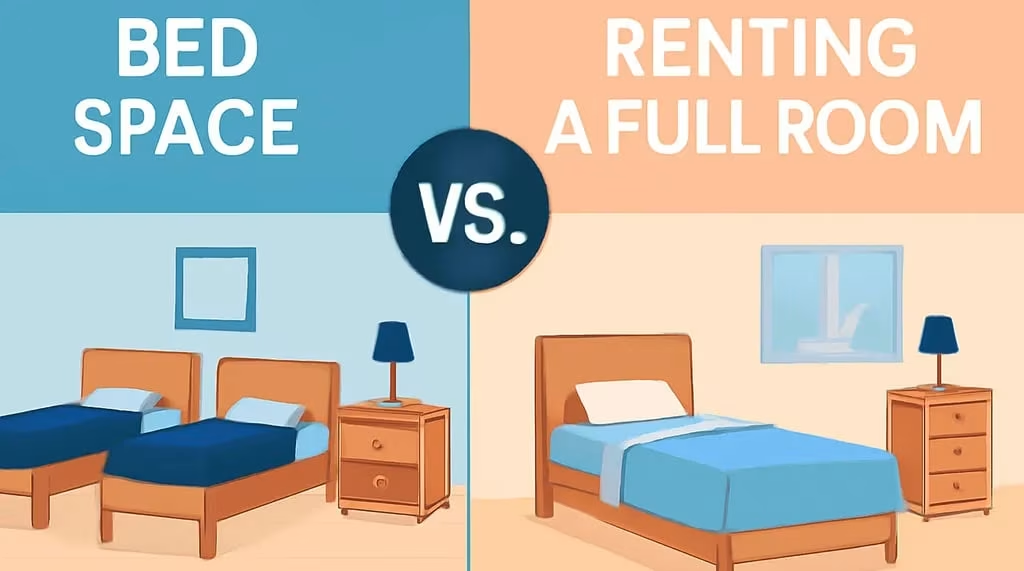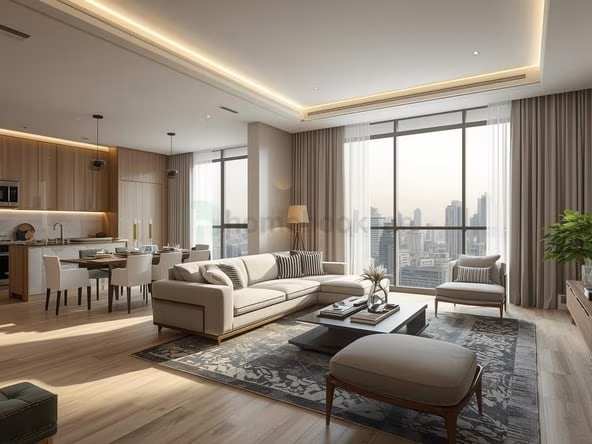When it comes to finding accommodation, one of the most pressing decisions is whether to rent a bed space or a full room. While both serve the basic purpose of providing shelter, they cater to vastly different needs, budgets, and lifestyles. Choosing between a bed space and a full room depends on several interrelated factors, including cost, location, comfort, security, and personal preferences. This article dives deep into each of these aspects to help you make a well-informed decision based on your lifestyle and budget.
Understanding the Basics: What Is a Bed Space and What Is a Full Room?
Before we compare, it’s important to define the two:
- Bed Space: A rented bed in a shared room, usually in a shared apartment or villa. Multiple tenants may share the same room (often 2–6 people), and common areas like the kitchen and bathroom are shared by everyone in the unit. This is the most affordable form of accommodation and is popular among working-class expats, students, and bachelors.
- Full Room: A private room in a shared apartment or villa. The tenant has exclusive use of the bedroom but shares the living room, kitchen, and bathroom with other housemates. Full rooms cost more but offer a balance of affordability and privacy.
Cost Considerations

1. Bed Space: The Budget-Friendly Option
Renting a bed space is generally much more affordable than a full room, making it an ideal choice for students, entry-level workers, or anyone on a tight budget. Since the rent is shared among multiple occupants, it significantly reduces monthly expenses and can be a smart way to live in high-demand areas without overspending.
Many bed spaces also include utilities and internet in the rent, offering predictable monthly costs and easing financial stress. In contrast, a full room offers more privacy but usually comes with a higher rent and separate bills for electricity, water, and internet, which can quickly add up.
Ultimately, the decision comes down to financial priorities: bed spaces offer cost-efficiency, while full rooms offer comfort at a higher price.
2. Full Room: Pay More for Privacy
A full room provides a much higher level of privacy and comfort compared to a shared bed space, but it also comes with a higher price tag. Monthly rent for private rooms in shared apartments typically falls within the mid-range price bracket, making them more expensive than shared spaces but still more affordable than renting an entire unit.
In more desirable or central areas, prices can be significantly higher, reflecting the location and quality of amenities.Even so, opting for a full room is often still more cost-effective than renting a studio or one-bedroom apartment, which usually demands a much larger monthly payment—especially when utilities and other living expenses are added.
Location and Accessibility: Proximity to Work and Services
1. Bed Spaces Near Key Commercial and Industrial Hubs
Proximity to essential amenities and institutions, such as universities, workplaces, public transportation, grocery stores, and healthcare facilities, plays a key role in choosing between a bed space and a full room. For many individuals—especially students and early-career professionals—being close to campus or their place of employment can reduce commute times, lower transportation costs, and improve overall quality of life.
Bed spaces are frequently offered in shared accommodations near university districts or commercial hubs, making them a convenient option for students or individuals with irregular work hours. Living nearby allows quick access to classes, libraries, and campus resources without relying heavily on public transport or personal vehicles.
Additionally, the availability of nearby shops, cafes, laundromats, and fitness centers can greatly influence rental decisions. Tenants often prioritize locations where daily needs can be met within walking distance or a short commute. In this regard, bed spaces tend to be situated in densely populated areas that cater to high student or worker demand, while full rooms may be found in more residential or quieter neighborhoods with a different set of lifestyle advantages.
Ultimately, the choice often comes down to balancing convenience with comfort. Some may prioritize being close to everything, even if it means sharing a space, while others may be willing to travel farther for the sake of privacy and a quieter environment.
2. Full Rooms in Well-Served Communities
Full rooms are commonly available in a wide range of urban and residential areas, particularly in neighborhoods that attract working professionals and middle-income tenants. These locations often provide convenient access to essential amenities such as supermarkets, gyms, green spaces, and public transit options, making them appealing for individuals who value both comfort and connectivity in their daily routine.
Another advantage of renting a full room—especially in villa-style or low-rise housing—is the availability of parking, which is a major benefit for those who own or regularly use a vehicle. This added convenience enhances the overall living experience and makes such accommodations more desirable for long-term stays.
Comfort and Privacy: Balancing Space and Social Life
1. Bed Space Living: Shared but Social
One of the major trade-offs with bed space living is limited personal space:
- You share your room with others—sometimes in bunk bed arrangements.
- Storage is limited, and personal privacy is minimal.
- Bathrooms and kitchens are often crowded, especially during peak times like early mornings or late evenings.
However, many tenants appreciate the social atmosphere—especially those new to the city. It offers a chance to make friends, share resources, and reduce loneliness.
2. Full Room Living: The Comfort of Personal Space
With a full room, you get:
- A private room with a lock and your own furniture (or the option to furnish it yourself).
- More control over your sleep schedule, noise level, and hygiene.
- Shared access to the kitchen and living area—but with fewer people.
This arrangement is especially popular among couples, young professionals, or anyone who values mental peace and quiet.
Security and Safety: Peace of Mind Matters
Security is a crucial consideration when choosing any type of shared accommodation, whether it’s a bed space in a multi-occupant unit or a private full room in a shared apartment. Living with others naturally brings concerns about privacy, personal belongings, and general safety. Therefore, it’s essential to ensure that the property adheres to established safety standards and legal regulations before moving in.
1. What to Watch for in Bed Spaces
Bed spaces are often located in partitioned units within apartments or villas that have been subdivided to accommodate more tenants. While this helps make housing more affordable, it can sometimes come at the cost of proper safety measures. In some cases, partitions are built hastily without permits, and the structure may not meet basic fire or ventilation requirements.
One of the most common issues with bed space accommodations is overcrowding. Having too many people in a confined space not only reduces comfort but can also increase health and fire hazards. Shared kitchens and bathrooms are used more frequently, which raises hygiene concerns and the potential for interpersonal conflicts.
Before committing to a bed space, it’s wise to ask specific questions such as:
- Is the unit officially registered with local housing authorities?
- Are there working fire alarms, fire exits, and extinguishers?
- Does the property have CCTV cameras, secure locks, and a visitor management system?
If the answers are unclear or avoided, it may be a red flag that the property is not compliant with housing standards.
2. Full Rooms: Generally Safer, but Still Variable
While full rooms tend to offer a higher degree of safety and personal space, they’re not automatically risk-free. The quality of security can vary depending on the type of building, the number of occupants, and the property management practices.
Full rooms located in professionally managed buildings or gated residential complexes often benefit from better infrastructure. These places are more likely to include:
- 24/7 security guards or reception desks
- Surveillance systems in common areas
- Controlled access points using key cards or codes
- Regular maintenance checks and compliance with fire safety rules
Another safety advantage of renting a full room is that you generally share the space with fewer people, which minimizes the risk of theft or interpersonal issues. With fewer tenants, it’s easier to establish boundaries, build trust, and keep shared areas cleaner and more secure.
3. Avoiding Scams and Unsafe Rentals
Whether you’re renting a bed space or a full room, always exercise caution. Visit the property before paying, ask for a written agreement, and confirm the landlord’s legitimacy. Be wary of deals that seem too cheap or require cash without a receipt, and check online reviews when possible.
Social and Cultural Compatibility
Sharing accommodation with others—especially in shared rooms—often requires adapting to a mix of cultural backgrounds, personal routines, and social habits. This kind of living arrangement can be both challenging and enriching, offering the chance to interact with people from various walks of life while also navigating differences in lifestyle.
1. Bed Space Etiquette and Common Challenges
In shared bed spaces, roommates may have different customs, dietary preferences, and hygiene standards, which can sometimes lead to misunderstandings or discomfort. Small conflicts may arise over sleep schedules, noise levels, cleanliness, or shared use of kitchens and bathrooms. Space is limited, and privacy is minimal, so adjusting to one another’s habits requires patience, respect, and communication.
2. Full Room: Greater Privacy and Fewer Conflicts
Opting for a private room within a shared unit allows for clearer personal boundaries and more autonomy. Even when living with housemates, having a space to call your own provides a sense of control and mental peace. You can maintain your own routine, organize your belongings as you like, and enjoy downtime without constant interaction, which helps reduce daily friction and promotes overall comfort.
Legal and Contractual Aspects
Subletting—which is the basis for many bed space arrangements—is often situated in a legal gray area, with limited oversight and protection for tenants.
1. Bed Spaces: Informal and Risk-Prone
Many bed spaces are rented without formal contracts, often through verbal agreements or casual arrangements made by current tenants or landlords. This informality can leave tenants with little to no legal protection, especially in cases of disputes or sudden rent increases. If the space becomes overcrowded or fails to comply with housing regulations, tenants may be at risk of sudden eviction with little recourse or warning.
For example, in Dubai, which is a metropolitan city with strict housing regulations, authorities frequently inspect properties for compliance. If you’re looking for a bed space for rent in Dubai, it’s important to choose one that meets legal standards to avoid issues like overcrowding or sudden eviction.
2. Full Rooms: More Regulated and Legally Secure
In contrast, full rooms are usually rented as part of formal lease agreements with the landlord or the main leaseholder. Tenants are often included in the official contract, which provides greater legal protection, particularly regarding eviction rules, rent limits, and deposit refunds. These arrangements tend to be more transparent and compliant with housing laws, offering renters peace of mind and a stronger sense of security.
Long-Term Value and Living Experience
Your choice of accommodation isn’t just about short-term savings—it also shapes your quality of life, productivity, and even mental health.
- Students and new expats may find bed spaces a good stepping stone while they find jobs and save money.
- Professionals and couples may prefer full rooms for better work-life balance and peace of mind.
There’s no universal solution when it comes to choosing between a bed space and a full room—the right option depends on your personal circumstances, lifestyle preferences, and how much privacy you’re comfortable giving up. Bed spaces are typically the more budget-friendly choice, making them suitable for students, newcomers, or individuals with limited financial flexibility. However, they often come with reduced privacy, basic comfort, and less formal rental arrangements.
On the other hand, a full room offers significantly more privacy, security, and personal space, though at a higher cost. It’s a better fit for those who plan to stay longer, work from home, or simply prefer a more independent living experience. Regardless of which option you choose, it’s important to ensure the property is safe, legal, and meets your daily living needs.
Frequently Asked Questions
Renting a bed space is only legal if the property and contract are registered with Ejari. Many shared setups aren’t, so always check first.
Never pay in advance without seeing the space and meeting the landlord. Use trusted platforms, and double-check paperwork before handing over money.
You’ll need your Emirates ID, passport, and a copy of your visa. For a full room, ask for an official tenancy contract too.
Yes, but only if you follow the contract and leave the place in good shape—document everything at check-in.
Most bed spaces include utilities and WiFi in the price, while private rooms might vary. Always clarify what’s covered before you sign.



